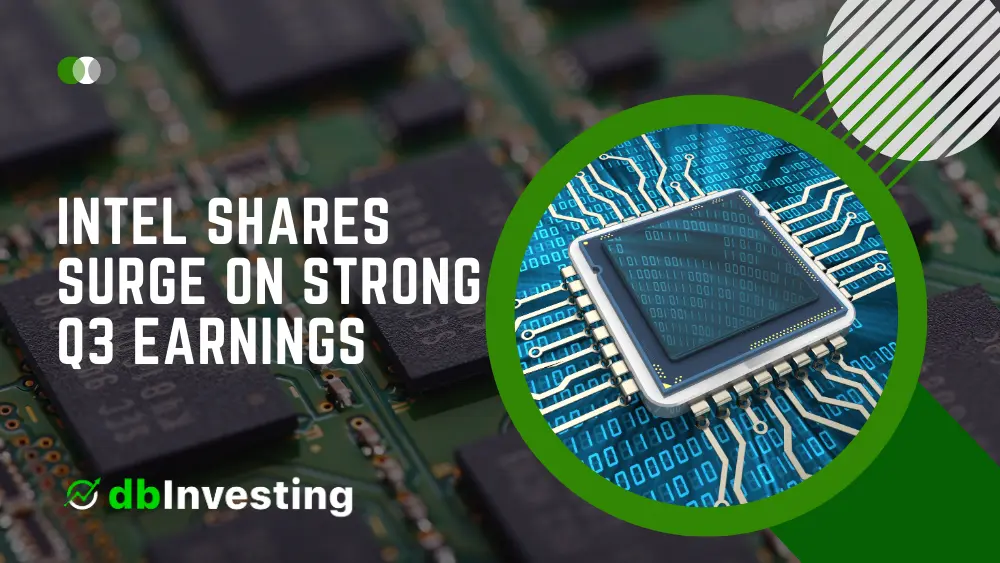Intel’s shares surged by approximately 7% during after-hours trading following the release of the company’s third-quarter earnings report on Thursday. Despite a decline in revenue from the same period last year, the company managed to surpass profit and sales expectations.
In the quarter ending on Oct. 1, Intel outperformed LSEG (formerly Refinitiv) consensus predictions as follows:
- Earnings per share stood at 41 cents, adjusted, compared to the expected 22 cents.
- Revenue reached $14.16 billion, exceeding the anticipated $13.53 billion.
Looking ahead to the fourth quarter, Intel anticipates adjusted earnings of 23 cents per share, with projected revenues ranging between $14.6 billion and $15.6 billion. This forecast contrasts with LSEG’s expectation of 32 cents per share on $14.31 billion in sales.
Notably, Intel reported a net income of $297 million, or 7 cents per share, for the current quarter, compared to $1.02 billion, or 25 cents per share, in the corresponding period of the previous year. The company’s gross margin for the quarter remained stable year over year at 45.8%.
Despite the seventh consecutive quarter of declining sales, Intel assured investors of an anticipated revenue rebound in the current quarter. To cut costs, Intel’s CEO Pat Gelsinger revealed plans to reduce expenses by approximately $3 billion this year. Chief Financial Officer David Zinsner highlighted a 15% decrease in operating expenses compared to the previous year, contributing to improved earnings per share. Intel’s workforce has also seen a reduction, now standing at 120,300 employees compared to 131,500 a year ago.
Business unit performance highlights for Intel included:
- Sales in the Client Computing group, encompassing laptop and PC processor shipments, decreased by 3% to $7.9 billion.
- The Data Center and AI division, offering server chips, experienced a 10% decline in sales, reaching $3.8 billion. Intel attributed this decrease to competitive pressure and a smaller market for server processors.
- Mobileye, Intel’s publicly traded subsidiary specializing in self-driving car components, reported an 18% growth in sales, reaching $530 million.
- Intel’s nascent chip-manufacturing business, known as Intel foundry services, saw a significant growth of nearly 300%, generating $311 million in revenue from the year-earlier period. Intel attributed this growth to a major customer commitment and prepayment.
- Sales in the network and edge division, responsible for selling networking parts, experienced a 32% decrease, amounting to $1.5 billion.
Intel’s recent decision to treat its programmable chip unit as a separate business and prepare for its listing on public markets within two years was also highlighted. The unit, currently part of Intel’s Data Center and AI group, saw a sequential sales decline during the quarter due to an inventory burn in the FPGA business.
Regarding Intel’s future prospects, the company expressed confidence in the applicability of its chips in artificial intelligence applications, particularly for running models on local devices rather than in the cloud. While acknowledging the shift of some server customers towards AI chips such as those made by Nvidia, Gelsinger remained optimistic about signs of normalization as the company entered the fourth quarter.
In response to reports of Nvidia and AMD developing Arm-based chips to compete in the PC market, Gelsinger downplayed the potential impact, citing the historical insignificance of Arm chips in the PC business. He also emphasized Intel’s readiness to manufacture Arm PC chips.
Intel maintained its commitment to catching up with Taiwan Semiconductor Manufacturing Co.’s chipmaking technology by 2025, a goal coined as “five nodes in four years.”
Gelsinger remarked, “While many thought our ambitions were a bit audacious when we began our ‘five nodes in four years’ journey roughly two and a half years ago, we have increasing line of sight towards achieving our goal.”



